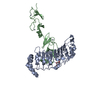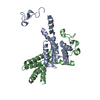[English] 日本語
 Yorodumi
Yorodumi- PDB-1uel: Solution structure of ubiquitin-like domain of hHR23B complexed w... -
+ Open data
Open data
- Basic information
Basic information
| Entry | Database: PDB / ID: 1uel | ||||||
|---|---|---|---|---|---|---|---|
| Title | Solution structure of ubiquitin-like domain of hHR23B complexed with ubiquitin-interacting motif of proteasome subunit S5a | ||||||
 Components Components |
| ||||||
 Keywords Keywords | GENE REGULATION/protein binding / UBL / UIM / RIKEN Structural Genomics/Proteomics Initiative / RSGI / Structural Genomics / GENE REGULATION-protein binding COMPLEX | ||||||
| Function / homology |  Function and homology information Function and homology informationXPC complex / DNA damage sensor activity / regulation of proteasomal ubiquitin-dependent protein catabolic process / proteasome accessory complex / proteasome regulatory particle, base subcomplex / cellular response to interleukin-7 / Proteasome assembly / proteasome binding / polyubiquitin modification-dependent protein binding / embryonic organ development ...XPC complex / DNA damage sensor activity / regulation of proteasomal ubiquitin-dependent protein catabolic process / proteasome accessory complex / proteasome regulatory particle, base subcomplex / cellular response to interleukin-7 / Proteasome assembly / proteasome binding / polyubiquitin modification-dependent protein binding / embryonic organ development / proteasome complex / Josephin domain DUBs / ubiquitin binding / N-glycan trimming in the ER and Calnexin/Calreticulin cycle / nucleotide-excision repair / DNA Damage Recognition in GG-NER / Formation of Incision Complex in GG-NER / single-stranded DNA binding / spermatogenesis / molecular adaptor activity / proteasome-mediated ubiquitin-dependent protein catabolic process / damaged DNA binding / RNA polymerase II-specific DNA-binding transcription factor binding / RNA polymerase II cis-regulatory region sequence-specific DNA binding / RNA binding / nucleoplasm / identical protein binding / nucleus / cytosol Similarity search - Function | ||||||
| Biological species |  Homo sapiens (human) Homo sapiens (human) | ||||||
| Method | SOLUTION NMR / simulated annealing procedure in CNS, further refined by AMBER 7 | ||||||
 Authors Authors | Fujiwara, K. / Tenno, T. / Jee, J.G. / Sugasawa, K. / Ohki, I. / Kojima, C. / Tochio, H. / Hiroaki, H. / Hanaoka, H. / Shirakawa, M. / RIKEN Structural Genomics/Proteomics Initiative (RSGI) | ||||||
 Citation Citation |  Journal: J.Biol.Chem. / Year: 2004 Journal: J.Biol.Chem. / Year: 2004Title: Structure of the Ubiquitin-interacting Motif of S5a Bound to the Ubiquitin-like Domain of HR23B Authors: Fujiwara, K. / Tenno, T. / Sugasawa, K. / Jee, J.G. / Ohki, I. / Kojima, C. / Tochio, H. / Hiroaki, H. / Hanaoka, F. / Shirakawa, M. | ||||||
| History |
|
- Structure visualization
Structure visualization
| Structure viewer | Molecule:  Molmil Molmil Jmol/JSmol Jmol/JSmol |
|---|
- Downloads & links
Downloads & links
- Download
Download
| PDBx/mmCIF format |  1uel.cif.gz 1uel.cif.gz | 862 KB | Display |  PDBx/mmCIF format PDBx/mmCIF format |
|---|---|---|---|---|
| PDB format |  pdb1uel.ent.gz pdb1uel.ent.gz | 730.5 KB | Display |  PDB format PDB format |
| PDBx/mmJSON format |  1uel.json.gz 1uel.json.gz | Tree view |  PDBx/mmJSON format PDBx/mmJSON format | |
| Others |  Other downloads Other downloads |
-Validation report
| Arichive directory |  https://data.pdbj.org/pub/pdb/validation_reports/ue/1uel https://data.pdbj.org/pub/pdb/validation_reports/ue/1uel ftp://data.pdbj.org/pub/pdb/validation_reports/ue/1uel ftp://data.pdbj.org/pub/pdb/validation_reports/ue/1uel | HTTPS FTP |
|---|
-Related structure data
| Similar structure data | |
|---|---|
| Other databases |
- Links
Links
- Assembly
Assembly
| Deposited unit | 
| |||||||||
|---|---|---|---|---|---|---|---|---|---|---|
| 1 |
| |||||||||
| NMR ensembles |
|
- Components
Components
| #1: Protein | Mass: 10750.396 Da / Num. of mol.: 1 / Fragment: ubiquitin-like domain (RESIDUES 1-95) Source method: isolated from a genetically manipulated source Source: (gene. exp.)  Homo sapiens (human) / Plasmid: pET24d / Production host: Homo sapiens (human) / Plasmid: pET24d / Production host:  |
|---|---|
| #2: Protein/peptide | Mass: 5198.620 Da / Num. of mol.: 1 / Fragment: ubiquitin-interacting motif (RESIDUES 201-248) Source method: isolated from a genetically manipulated source Source: (gene. exp.)  Homo sapiens (human) / Plasmid: pET11d / Production host: Homo sapiens (human) / Plasmid: pET11d / Production host:  |
-Experimental details
-Experiment
| Experiment | Method: SOLUTION NMR |
|---|
- Sample preparation
Sample preparation
| Details | Contents: U-15N, U-13C Solvent system: 20mM potassium phosphate buffer (pH 6.8), 5mM KCl, 90% H2O, 10% D2O |
|---|---|
| Crystal grow | *PLUS Method: other / Details: NMR |
-NMR measurement
| Radiation | Protocol: SINGLE WAVELENGTH / Monochromatic (M) / Laue (L): M | |||||||||||||||
|---|---|---|---|---|---|---|---|---|---|---|---|---|---|---|---|---|
| Radiation wavelength | Relative weight: 1 | |||||||||||||||
| NMR spectrometer |
|
- Processing
Processing
| NMR software | Name:  Amber / Version: 7 / Classification: refinement Amber / Version: 7 / Classification: refinement |
|---|---|
| Refinement | Method: simulated annealing procedure in CNS, further refined by AMBER 7 Software ordinal: 1 Details: RESIDUES INCLUDING MET1 THROUGH THR75 OF HHR23B AND LEU278 THROUGH GLN 296 OF S5A ARE ORDERED IN SOLUTION, WHILE THE REST IS HIGHLY FLEXIBLE (BASED ON 1H-15N HETERONUCLEAR NOE ANALYSIS). |
| NMR ensemble | Conformer selection criteria: The submitted conformer models are the 20 structures with the lowest Conformers calculated total number: 100 / Conformers submitted total number: 20 |
 Movie
Movie Controller
Controller








 PDBj
PDBj






